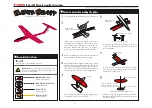
Matrize
PN 539 685-2
411-18132 / Rev. C1
Die Set
PN 539 685-2
411-18132 / Rev. C1
Seite /
Page
9 of 11
7 Maintenance / Inspection
7.1
Daily Maintenance
Tyco recommends that operators of the tool be made
aware of the following steps of daily maintenance:
1. Remove dust, moisture, and any other
contaminants from the tool with a clean, soft
brush, or a clean, soft, lint-free cloth. Do NOT use
hard or abrasive objects that could damage the
tool.
2. Make certain that the pivot pins are in place and
that they are secured with retaining plate and that
locking screw of the adjustment wheel is tight.
3. All pins, pivot points, and bearing surfaces should
be protected with a thin coat of any good SAE No.
20 motor oil. Do not oil excessively.
4. When the tool is not in use, keep handles closed
to prevent objects from becoming lodged in the
crimping jaws. Store the tool in a clean, dry area.
7.2 Periodic Inspection
Regular inspections of the tool should be performed
by quality control personnel. A record of scheduled
inspections should remain with the tool or be supplied
to supervisory personnel responsible for the tool.
Inspection frequency should be based upon amount
of usage, working conditions, operator training and
skill and established company standards.
1. Remove all lubrication and accumulated film by
immersing the tool (handles partially closed) in a
suitable commercial degreaser that will not affect
paint or plastic material.
2. Make certain that all pivot pins are in place and
secured with retaining plates.
3. Close tool handles until ratchet releases and then
allow them to open freely. If they do not open
quickly and fully, the spring is defective and must
be replaced.
4. Inspect the tool frame for wear or damage, paying
particular attention to the tool jaws and pivot
points.
7 Wartung, Instandhaltung
7.1 Tägliche Wartung
Zur täglichen Wartung sind folgende Schritte durch-
zuführen:
1. Entfernen Sie vom Werkzeug Staub, Feuchtigkeit
und andere Rückstände mit einer sauberen, wei-
chen Bürste oder einem fusselfreien Tuch. Ver-
wenden Sie keine harten oder abschleifenden
Mittel, mit denen das Werkzeug beschädigt wer-
den könnte.
2. Stellen Sie sicher, daß der Lagerbolzen einge-
setzt und durch die Sicherungsscheibe gehalten
wird und die Schaftschraube zur Sicherung des
Einstellrades fest ist.
3. Versehen Sie alle Stifte, Drehpunkte und Lager-
oberflächen mit einem dünnen Ölfilm eines guten
SAE 20 Motoröls. Ölen Sie aber nicht übermäßig.
4. Wird die Handzange nicht benötigt, dann schlie-
ßen Sie die Zangengriffe und lagern die Zange
sauber und trocken.
7.2 Periodische Überprüfung
Eine Überprüfung der Crimpzange sollte durch quali-
fiziertes Personal regelmäßig (je nach Nutzung) durch-
geführt und aufgezeichnet werden.
1. Entfernen Sie jegliche Schmiermittel und Rück-
stände, indem Sie die Handzange (Griffe teilweise
geschlossen) in ein Fett-Lösemittel eintauchen,
das Farbe und Kunststoffe nicht angreift.
2. Stellen Sie sicher, daß alle Lagerbolzen einge-
setzt und durch Sicherungsscheiben gehalten
werden.
3. Schließen Sie die Zangengriffe bis der Ratschen-
mechanismus auslöst bzw. öffnet, und lassen Sie
die Zangengriffe frei öffnen. Öffnen die Griffe nicht
schnell und vollständig, dann ist die Feder be-
schädigt und muß ersetzt werden.
4. Überprüfen Sie die Zange auf Abnutzung und
Beschädigung, insbesondere im Bereich der
Crimpbacken und Drehzapfen.





























